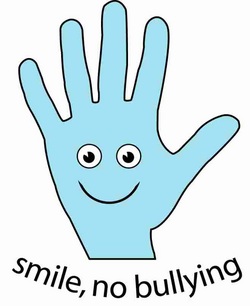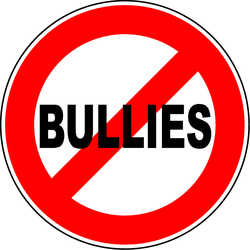Tips for Teachers
There are many ways of intervening with situations involving bullying.
Below are examples of Do's and Don'ts when interfering with bullying situations.
For a full list of Do's and Dont's, visit Teaching Tolerance, "Bullying: Guidelines for Teachers"
Below are examples of Do's and Don'ts when interfering with bullying situations.
For a full list of Do's and Dont's, visit Teaching Tolerance, "Bullying: Guidelines for Teachers"
The Do's:

Stop the bullying immediately.
Stand between the bullied student and the bully(ies), blocking eye contact. Don't send any bystanders away. To avoid escalating the tension, wait until later to sort out the facts. Talk to the parties involved separately once they are calm.
Refer to school rules regarding bullying.
Speak in a matter-of-fact tone of voice to describe what you heard or saw. Let all
students know bullying is always unacceptable.
The Dont's:

Do not confuse bullying with conflict.
Bullying is a form of victimization, and addressing it as a "conflict" downplays the
negative behavior and the seriousness of the effects. Educators should strive to
send the message that "no one deserves to be bullied," and to let the bully know
the behavior is wholly inappropriate.
Do not use peer mediation.
It can be very upsetting for a child who has been bullied to face his or her tormentor in mediation. Giving both parties an equal voice can empower the bully and make the bullied student feel worse. In addition, there is no evidence that peer mediation is
effective in stopping bullying.
Bullying is a form of victimization, and addressing it as a "conflict" downplays the
negative behavior and the seriousness of the effects. Educators should strive to
send the message that "no one deserves to be bullied," and to let the bully know
the behavior is wholly inappropriate.
Do not use peer mediation.
It can be very upsetting for a child who has been bullied to face his or her tormentor in mediation. Giving both parties an equal voice can empower the bully and make the bullied student feel worse. In addition, there is no evidence that peer mediation is
effective in stopping bullying.
What can schools do to stop bullying?
Accordiing to "Consider Administeriing Staff Preventing Classroom Bullying: What Teachers Can Do" by Jim Wright, all segments of the school community must work together to address the problem of bullying. This means that teachers, administrators, parents, and students need to cooperate as they assess the scope of the bullying problem in their school and come up with ways to respond to it effectively. While every school will adopt an approach to bully prevention that meets its unique needs, all schools would benefit from the following guidelines (Batsche & Knoff, 1994):
- Conduct a thorough building-wide assessment to uncover the extent that bullying is a problem in your school. Use multiple methods to collect information. Consider administering staff Preventing Classroom Bullying: What Teachers Can Do includes6 surveys and anonymous student surveys, facilitating student and parent focus groups on the topic of bullying, analyzing the pattern of student disciplinary referrals to see if bullying patterns emerge, have adults observe and record bullying behaviors in less-supervised settings such as the cafeteria and on the playground, etc. Pool this information to identify significant patterns of bullying (for example, where and when bullying happens to occur most frequently; which students appear to engage in bullying behavior and which are victimized by bullies, etc.).
- Reach consensus as a staff about how your school defines bullying and when educators should intervene to prevent bullying from occurring. Rates of school bullying drop significantly when all staff members are able to identify the signs of bullying and agree to intervene consistently whenever they observe unsafe, disrespectful, or hurtful behaviors.
- Compile a ‘menu’ of appropriate consequences that educators can impose on students who bully. This menu should include lesser consequences that might be given for minor acts of bullying (e.g., mild teasing) and more stringent consequences for more serious or chronic bullying (e.g., inflicting physical harm, harassing a victim for weeks). Train staff to use the consequences-menu to ensure fairness and consistency when they intervene with bullies.
- Establish a policy for contacting the parent(s) of a student who has engaged in bullying. At the parent conference, school staff should attempt to enlist the parent to work with them to stop the student’s bullying. If the parent denies that a problem exists or refuses to cooperate to end the child’s bullying behavior, the parent should be told clearly that the school will monitor the child’s behavior
closely and will take appropriate disciplinary steps if future bullying incidents occur.
- Monitor the school’s bully-prevention efforts on an ongoing basis to see if they have in fact reduced the amount of bullying among students and improved the emotional climate of the building. The school can use the same monitoring methods to track progress in bully prevention as were first used to assess the initial seriousness of the bullying problem (e.g., focus groups, surveys, direct
observation, tracking of disciplinary referrals). Share these results periodically in the form of a ‘progress report’ with school staff, parents, and students to build motivation throughout the school community for your building’s bully-prevention initiative.
Accordiing to "Consider Administeriing Staff Preventing Classroom Bullying: What Teachers Can Do" by Jim Wright, all segments of the school community must work together to address the problem of bullying. This means that teachers, administrators, parents, and students need to cooperate as they assess the scope of the bullying problem in their school and come up with ways to respond to it effectively. While every school will adopt an approach to bully prevention that meets its unique needs, all schools would benefit from the following guidelines (Batsche & Knoff, 1994):
- Conduct a thorough building-wide assessment to uncover the extent that bullying is a problem in your school. Use multiple methods to collect information. Consider administering staff Preventing Classroom Bullying: What Teachers Can Do includes6 surveys and anonymous student surveys, facilitating student and parent focus groups on the topic of bullying, analyzing the pattern of student disciplinary referrals to see if bullying patterns emerge, have adults observe and record bullying behaviors in less-supervised settings such as the cafeteria and on the playground, etc. Pool this information to identify significant patterns of bullying (for example, where and when bullying happens to occur most frequently; which students appear to engage in bullying behavior and which are victimized by bullies, etc.).
- Reach consensus as a staff about how your school defines bullying and when educators should intervene to prevent bullying from occurring. Rates of school bullying drop significantly when all staff members are able to identify the signs of bullying and agree to intervene consistently whenever they observe unsafe, disrespectful, or hurtful behaviors.
- Compile a ‘menu’ of appropriate consequences that educators can impose on students who bully. This menu should include lesser consequences that might be given for minor acts of bullying (e.g., mild teasing) and more stringent consequences for more serious or chronic bullying (e.g., inflicting physical harm, harassing a victim for weeks). Train staff to use the consequences-menu to ensure fairness and consistency when they intervene with bullies.
- Establish a policy for contacting the parent(s) of a student who has engaged in bullying. At the parent conference, school staff should attempt to enlist the parent to work with them to stop the student’s bullying. If the parent denies that a problem exists or refuses to cooperate to end the child’s bullying behavior, the parent should be told clearly that the school will monitor the child’s behavior
closely and will take appropriate disciplinary steps if future bullying incidents occur.
- Monitor the school’s bully-prevention efforts on an ongoing basis to see if they have in fact reduced the amount of bullying among students and improved the emotional climate of the building. The school can use the same monitoring methods to track progress in bully prevention as were first used to assess the initial seriousness of the bullying problem (e.g., focus groups, surveys, direct
observation, tracking of disciplinary referrals). Share these results periodically in the form of a ‘progress report’ with school staff, parents, and students to build motivation throughout the school community for your building’s bully-prevention initiative.
Reading Resources
Books for children:
Bullies are a Pain in the Brain by Trevor Romain
-Advice on what to do when dealing with the issue of bullying in school
How to Handle Bullies, Teasers, and Other Meanies: A Book that Takes the Nuisance Out of Name Calling and Other Nonsense by Kate Cohen-Posey
-Tips for how kids can turn bullying around
Stand up for Yourself and Your Friends: Dealing with Bullies and Bossiness and Finding a Better Way by Patti Kelley Criswell
-Interactive activities for ways to notice bullying and what to do to stop it. This website is geared more for girls
Books for Educators:
Bullying Prevention Handbook: A Guide for Principals, Teachers, and Counselors by John H. Hoover
-A book that provides ways to understand and prevent bullying from occurring on a daily occurance
Bullying at School: What We Know and What We Can Do (Understanding Children’s Worlds) by Dan Olweus
-Helps identify the problem with bullying and ways to deal with it before it occurs and while it occurs
Bullies are a Pain in the Brain by Trevor Romain
-Advice on what to do when dealing with the issue of bullying in school
How to Handle Bullies, Teasers, and Other Meanies: A Book that Takes the Nuisance Out of Name Calling and Other Nonsense by Kate Cohen-Posey
-Tips for how kids can turn bullying around
Stand up for Yourself and Your Friends: Dealing with Bullies and Bossiness and Finding a Better Way by Patti Kelley Criswell
-Interactive activities for ways to notice bullying and what to do to stop it. This website is geared more for girls
Books for Educators:
Bullying Prevention Handbook: A Guide for Principals, Teachers, and Counselors by John H. Hoover
-A book that provides ways to understand and prevent bullying from occurring on a daily occurance
Bullying at School: What We Know and What We Can Do (Understanding Children’s Worlds) by Dan Olweus
-Helps identify the problem with bullying and ways to deal with it before it occurs and while it occurs
Assessment
Formative assessment can be an engaging classroom discussion with geared questions that the teacher can ask students about the resources, links, and books that were used to create a data base. The teacher can ask questions like: why did you chose those books in specific? How would you use those books? How did you find this information?
Another form of assessment can include a graphic organizer that studnets can use during their research to document their research.
